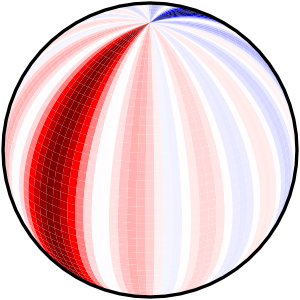rotsim2d.dressedleaf#
Associate polarizations, angular momentum factors and pathways amplitudes
with pathways. The time- and frequency-dependent signals are calculated in
rotsim2d.propagate.
Pathway represents a double-sided Feynmann pathway for third-order
rovibrational excitation, without associating it to any specific
molecule. DressedPathway specializes the object to specific vibrational
mode at a given temperature. The main quantity, calculable with
DressedPathway.amplitude(), is the pathway amplitude given by:
where \(\widetilde{\theta}\) and \(\widetilde{J}\) are the sequences of polarization angles and J values for the pathway. \(N_{\eta_i J_i}\) includes all relevant degeneracy factors (nuclear spin, rovibrational symmetry) and \(\langle T^{(0)}_0(\eta_iJ_i)^\dagger\rangle=(2J_i+1)^{-1/2}\).
The macroscopic polarization is related to the pathway amplitude by:
where \(N\) is the number density and \(\mathcal{I}(\widetilde{\omega}\text{ or } \widetilde{t})\) determines the n-dimensional frequency- or time-domain response. The absorption coefficient for the probe (in the Lambert-Beer law sense) is then given by:
Pathway#
|
Collect information on a pathway based on KetBra tree leaf without specializing it to any specific vibrational mode of a molecule. |
Attributes#
The leaf used to construct this pathway. |
|
Number of different optical frequencies requried to produce this pathway. |
|
ground-state hole-burning, excited-states absorption, etc. |
|
Shorthand notation for |
|
Two-letter identifier for the 2D peak. |
|
Short hand notation for series of transitions in the pathway. |
|
Ambiguous version of |
|
Coherences created by light-matter interactions. |
|
Time-ordered transitions between states for the pathway. |
|
Arguments for the G-factor. |
|
Ordering of polarization vectors in four-fold dipole-operator. |
|
\((-1)^\kappa\left(\frac{i}{2\hbar}\right)^n\), where n is the order of interaction (usually 3) and \(\kappa\) is the sign factor due to multiple interactions on either ket- or bra-side of the density matrix. |
|
Whether the molecule is in coherent state after second interaction. |
|
Pair of strings representing coherences created by first and third interaction (2D peak label). |
|
Same as peak but using P-, Q-, R-branch notation instead of absolute J numbers. |
|
List of Pathway attributes. |
Methods#
|
Make a list of Pathway's from KetBra tree. |
|
Make a list of Pathway's from KetBra list. |
|
Polarization tensor components \(T^{(0)}_0(\epsilon_i^{\ast}, \epsilon_j, \epsilon_k^{\ast}, \epsilon_l; k)\) for k=0,1,2 |
Geometric factors for k=0,1,2. |
|
|
Geometric R-factor for pathway intensity for isotropic initial density matrix. |
|
String representation including only attributes in |
|
Pretty print double-sided Feynmann diagram. |
|
Pretty print this pathway. |
DressedPathway#
|
Excitation pathway specialized to a vibrational mode. |
Attributes#
Vibrational mode associated with this pathway. |
|
Temperature in Kelvin. |
|
The const factor of |
Methods#
|
Make a list of DressedPathway's from KetBra tree. |
|
Make a list of DressedPathway's from KetBra list. |
|
Make a list of DressedPathway's from dict of parameters. |
Pressure-broadening coefficient of i coherence. |
|
Frequency of i-th coherence. |
|
|
Amplitude of the pathway, given by the product of isotropic coefficient of the initial density matrix, \(\langle T^{(0)}_0(\eta_i J_i)^\dagger\rangle=(2J_i+1)^{-1/2}\), |
Fraction of initial population excited by pump pulses. |
|
|
Pretty print this pathway. |
Peak2D#
|
Represent 2D IR resonance produced by multiple pathways. |
Attributes#
Pump wavenumber. |
|
Probe wavenumber. |
|
Peak identifier. |
|
Sum of pathway amplitudes producing the peak. |
|
Pathway intensity. |
|
Pathway intensity at the peak of the line, assuming Lorentzian profile. |
|
List of pathways backing this 2D resonance. |
|
p, pressure in atm; tw, waiting time in s; angles, polarization. |
Methods#
|
Return max abs. |
|
Make |
Peak2DList#
|
List of 2D peaks with easy access to pump, probe frequencies, peak intensities and peak identifiers. |
Attributes#
List of pump frequencies. |
|
List of probe frequencies. |
|
Peak strings. |
|
Peak amplitude--sum of |
|
Peak pathway intensities. |
|
Max peak intensity assuming Lorentzian profile. |
Methods#
|
|
|
Read peak list from HDF5 file. |
|
Calculate list of peaks based on toml input data. |
|
Save peak list to HDF5 file. |
|
Return peak with |
Sort peaks by amplitude. |
Top-level functions#
Labels#
|
Abstract ket (or bra) label, e.g: 1P, 0Q. |
|
Abstract label for |
|
Abstract label for |
|
Assign branch label, e.g: P, 2P, Q, to |
|
Conjugate coherence string, |ket><bra|->`|bra><ket|`. |
|
Conjugate last coherence string in peak identifier. |
Pathways#
|
Collect pathways with the same js. |
|
Collect pathways with the same 2D resonance. |
|
Pretty print a list of |
|
Pretty print a dict of pathways. |
|
Pretty print a dict of (pathway, float) tuples. |
Peaks#
|
Return peaks from |
Miscellaneous#
|
Rearrangement of polarizations allowed by symmetry. |
|
Rearrangement of J values allowed by symmetry. |
|
Remove degenerate tuples of Js. |
